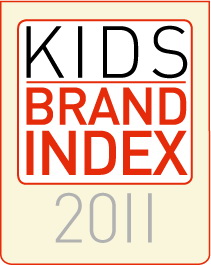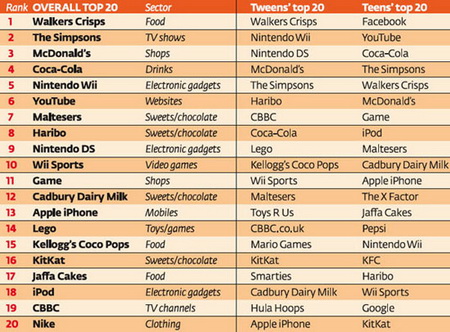A new report from Brand Republic and Harris Interactive shows a table of leading household brands that children like the most.
The report shows what 4,000 UK children aged 7 to 15 consider leading. There is also a division by age group (‘tweens’ aged 7 to 11 and ‘teens’ aged 12 to 15) and by gender.
The research was conducted online to reveal how 166 brands influence children and included such topics as: children’s awareness of the brands; how excited children get about the brands; how popular brands are among children; whether or not parents would approve of children consuming the brand; how cool children think brands are; whether children would recommend brands to others; which brands are children’s favorites; which brands are most fun; and which brands children simply want the most.
The brands’ marketing activity was also taken into account to reveal whether children have seen advertising by the brand and where they have seen it; and whether kids have visited a brand’s website.
Brands from 12 categories such as Food, Drinks, Sweets and chocolate, Clothes, Shops, TV channels, TV shows, Video games, Electronic gadgets, Toys and games, Mobile phones, Websites were researched. Each category was given an ‘excitement’ ranking. Children were only asked to compare brands from the same sector, says Campaign.
In brief, it turned out that all children are most excited by electronic gadgets with the Nintendo Wii to be the top performing one.
Food and drinks brands are also popular with preference to Maltesers (the top chocolate brand), KitKat, Coca-Cola and Haribo.
Teens chose Facebook as the top brand but it was ranked only 104 by tweens.
As for sport brands, Nike scored higher than rival Adidas overall, but Adidas was more popular than Nike among teenagers.
Android scored third in the mobiles category ahead of Orange, Nokia and Sony Ericsson.
Iconic Lego and Monopoly scored far higher than more modern brands such as Street Surfing and Nerf Guns.
Brands that parents did not approve of were generally seen as ‘cooler’.
The research resulted in a 194-page report containing tables that show how each brand succeeded in key areas. It also contains an individual write-up for each brand focusing on its performance. The full list of brands with index scores is available here.

